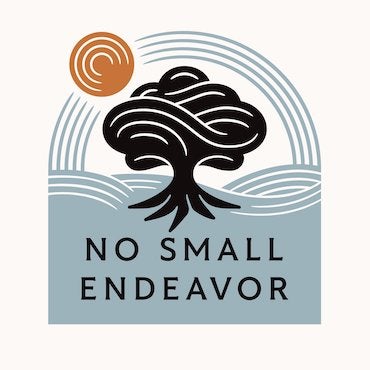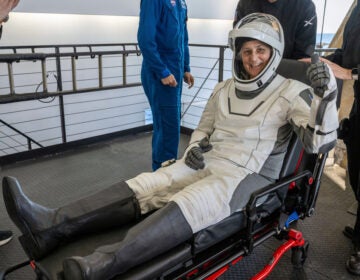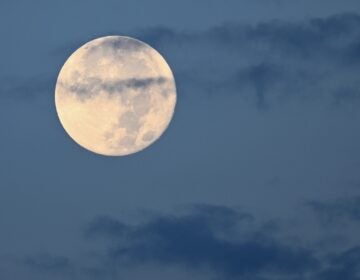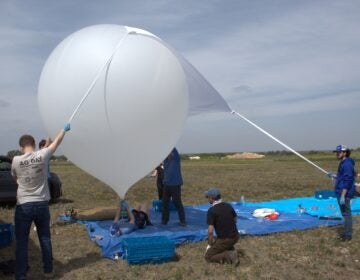NASA is looking for a few good names
ListenYou have until July 1st to sign up to send your name to Mars with MAVEN – first spacecraft dedicated to study of the upper atmosphere of Mars. Asteroid mining company Planetary Resources plans to launch asteroid-hunting telescopes in 2015. Summer Solstice was last Friday at 1:04 pm, the latest sunset is this Thursday, earliest sunrise WAS June 14th. Beginning of the season to catch the southern summer constellations Scorpius and Sagittarius.
June 24, 2013
[Dave Heller] Time’s running out! Listeners have until July 1st to sign up to send their names to Mars. Let’s login with Derrick Pitts, chief astronomer at the Franklin Institute. Derrick, this is less rigorous than training to be astronaut.
[Derrick Pitts] I’d say it’s indeed less rigorous, unless of course you have a pension for poetry. So here’s the story: The MAVEN spacecraft, which is due to launch for Mars in November of this year, is offering an opportunity for people to personalize it, if you will. Or make the journey in a less than physical way. There are two possibilities for what you can do. One is you can simply go to the website and enter your name and it will be included with all the other names of those who have heard about this as a way to get to Mars, send your name to Mars. But, if you really think you can do this, you can write a haiku. Write a haiku and submit it as part of a contest of the haiku that will be selected to be sent to Mars on the MAVEN spacecraft!
And in what form then will this compendium of names be sent in this spacecraft?
Well, it’ll all be assembled and put together on a DVD or a CD-ROM, some digital form like that so it can be compressed into a really tiny size. It’s something that NASA’s been doing the last several missions in order to get people more directly engaged with exploring the Red Planet.
What else is happening in terms of the exploration with MAVEN?
Well in MAVEN’s case, MAVEN is going to look at the upper atmosphere of Mars and examination of the upper atmosphere Mars is to try to better understand how the disappearance of upper atmosphere effected the history of water on the planet. So we know that the other rovers that are down on the surface are looking for evidence of water on Mars, looking for evidence of environments where water existed, where the possibility of life — the development of life — may have gone on. But we also realize that there’s no water ON the surface, although there looks like there was plenty of water! We’ve mentioned a number of times that there looks like there was an enormous amount of water. Where did it all go? The speculation is that there’s a connection between the disappearance of the water and the disappearance of Mars’ atmosphere, its upper atmosphere. So the examination of the upper atmosphere may give us some clues to help us better understand how all of that water that we think was on the surface of Mars is now gone, or how it disappeared.
“… There looks like there was an enormous amount of water [on Mars]. Where did it all go? The speculation is that there’s a connection between the disappearance of the water and the disappearance of Mars’ [upper] atmosphere.”
Derrick Pitts
So NASA’s not the only entity trying to engage the public.
No no, not at all. There are other space exploration entities that are trying to figure out what ways to get the public involved and fund their project at the same time. You know NASA depends, of course, on government funds to do what work it does. It’s a government agency and that makes perfect sense. But as a government agency, as we look at the austerity measures that are being employed right now to keep spending down is there is a sequestration that’s been put on NASA that’s restricting what that agency can do. It can’t do this but other public entities in space exploration are doing something really interesting called crowd sourcing, or crowd funding. And so what they’re asking people to do is to go to a particular website and donate money. And in this way they can pursue their interest in space exploration. So if you think you’re really interested in learning about what kind of materials are available for mining on asteroids, put your money where your mouth is. Put up your buck to support this kind of space exploration. And as it turns out, there is a space mining company that needed one million dollars by last week, I think it was, in order to put cameras on board the spacecraft so people could watch as the spacecraft went out to observe the mining operations, or once the spacecraft gets launched in 2015. They got the one million dollars and it’s pointing toward the possibility, an expanding possibility, of companies like this being able to fund their work through crowd funding.
-
Asteroid Mining Mission Revealed by Planetary Resources, Inc.
Derrick, we bid adieu to summer solstice last week and now the latest sunset is at hand.
Yes, it comes up this Thursday, we have the latest sunset. Now this couples with the earliest sunrise, which was on June 14, so we have the straddling of the 21st. And of course this is all related to the Earth’s motion around the sun, the orbital mechanics of that sort of spread things out. But this is the time of year to really, really enjoy these long deep sunsets, because right now the sun is setting at about 8:35 in the evening, the sky doesn’t get dark until about 9:10, 9:15 or so. It’s a beautiful time to go out and take a look toward the western horizon where you can easily see Venus without much difficulty at all. Mercury’s getting a little bit harder because it’s now sinking much lower to the horizon after sunset, disappearing from view. We won’t see it again for another few months, but then over on morning side of the sky. So Venus dominates the west, it’s holding court over there on that side. And of course Saturn is still nice and high in the southern sky. As the sky really gets dark it’s a great time to view it.
And we have a moment left — there’s also the advent of southern summer constellations.
That’s right. In the south sky right now through the next month or so, we’ll be able to see two really bright constellations: Sagittarius and Scorpius. One looks like a scorpion, the other looks like a teapot; but the stars are bright and easy for all to see.
-
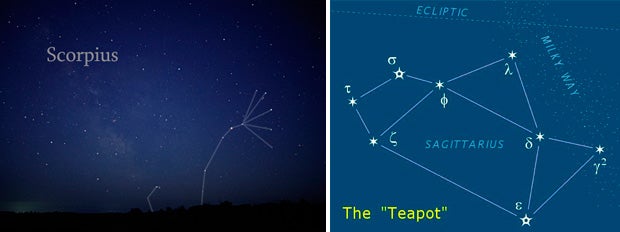
Photo credits: Wikipedia
WHYY is your source for fact-based, in-depth journalism and information. As a nonprofit organization, we rely on financial support from readers like you. Please give today.

